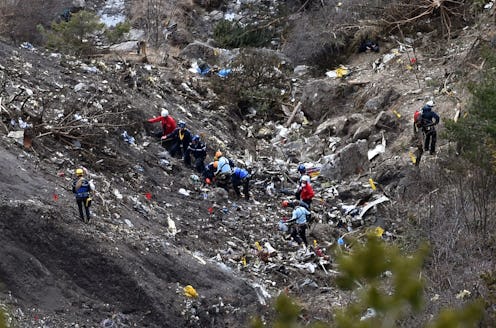News
How Did The Germanwings Video Survive The Crash?
Reports of the existence of a video of the Germanwings crash, filmed from inside the aircraft on a cell phone and later extracted from the memory card, have got everyone talking: is the video real (German and French media say yes) or not (the chief French prosecutor had never heard of it)? But another question remains: how does cell phone footage survive a plane crash? Given the massive impact evidenced by the A320’s debris and the complete carnage that ensued, the video’s teeny vehicle (described simply as a mobile phone) has been through a lot.
Regardless of whether or not the footage should be shown publicly, the fact that intact data encrypted on a cell phone memory may actually have survived the crash seems somewhat insane. A Lufthansa spokesperson, in response to the news, said the company did not know of the video, but added: “Considering that everything on the plane was destroyed, it would be unusual for a mobile phone to survive the impact.”
Breitbart's John Hayward writes that he initially assumed the footage must have been uploaded to cloud storage and accessed from there. But, he points out, French police did reportedly find relatively intact cell phone materials from the debris.
This admission, Hayward says, implies that the authorities have not yet managed to extract any useful information from the recovered phones. A French Gendarmerie spokesperson told CNN that he believed the recovered cell phones would need to be delivered to the Criminal Research Institute in Rosny-sous-Bois (near Paris) to be examined by specialist technicians. This has not so far happened, although one suspects it will shortly in the light of this most recent supposed discovery. In fact, chief French prosecutor Brice Robin demanded Wednesday that anyone with videos of the crash hand over the footage immediately.
Julian Reichelt, editor-in-chief of Bild (a German newspaper that published reports of the video alongside French magazine Paris Match), told CNN that the two publications are “very confident” that the video is real. Neither publication showed the apparently harrowing video, instead they settled with describing its contents. In their report, Bild interviewed a mobile phone expert to find out how such a video may have made it through the trauma of the crash. Cell phone tester Dirk Lorenz told them:
It’s very unlikely a mobile phone could have survived such an impact. … However, a memory card can be very durable. … Even if a mobile phone smashes into a thousand pieces, the memory card can remain intact. For example, if the impact was somewhat cushioned.
Given the proven inability of smart-phones to handle even light household trauma, it comes as no surprise that they’d be pulverized in a plane crash. By contrast, memory cards are seemingly built with more of an eye to longevity. We don’t know the type of card involved, obviously, but we can look at the playing field. SanDisk, for example, promises that its memory chips are “tested under harsh conditions.” The products should, supposedly, be able to withstand: three days submerged in a small volume of water; temperatures between -13ºF and 185ºF (for 100 cycles, or 28 hours); 500Gs of shock; drops of up to 16.4 feet; and impact equivalent of being run over by a 5 ton delivery truck.
There are rumors that SD cards do make it alive through wash cycles, and Samsung has released a range of heavy-duty metal-brushed cards touted as “waterproof, shockproof, and magnet proof.”
All very impressive, but coming out the other side of a normal wash cycle surely doesn’t ensure a memory card’s survival in a high-impact plane crash. After all, black boxes are specifically designed to endure crashes: black box manufacturer Honeywell told NBC News that their products should survive impacts up to 3,400 times the force of gravity, ocean depths of 20,000 feet and the extreme temperatures of fire and ice. Yet black boxes have been known to be destroyed. In 2005, when a Cypriot passenger plane went down in Greece, one of the vehicle’s black boxes was rendered utterly useless, despite being designed to survive up to 2,000ºF (quite a bit more than their puny memory card relatives).
But, even if it seems unlikely, Bild's expert makes clear that it is possible; indeed, the fact that things we fabricate tend to outlast human beings has provided poets throughout time with endless pathos. A Gizmodo report on the MH370 disaster, weeks after the Malaysia Airlines plane disappeared, suggested that even the cell phones on that ill-fated vehicle would still be recoverable (once found). A representative of 4Discovery, a mobile phone data forensics firm, told CNN (as reported by Gizmodo) that the material was likely to be recoverable even after months underwater. “As long as the data cards are intact, the information is still there,” the expert said.
Given the reports of “relatively intact” mobile devices at the Germanwings crash, it seems likely that the authorities have found intact SIM cards, and thus have access to extractable material. If that’s the case, this investigation is presumably about to delve into a whole cache of potential evidence.
Images: Getty Images (4)
